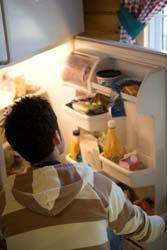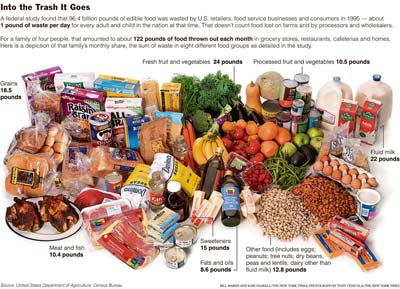How Much Food Do Americans Throw Away?!
by www.SixWise.com
While about 1 billion people globally do not have enough to eat, Americans toss out about 40 percent of all U.S.-produced food, a new study finds.
|

Americans toss out 1,400 calories worth of food per person, per day.
|
The estimate, published in the journal PLoS One, found food waste per person has increased 50 percent since 1974. In all, 1,400 calories worth of food are thrown out per person, per day, amounting to 150 trillion calories a year.
Researchers came up with the estimate by calculating the difference between the U.S. food supply and what’s actually eaten, using a model of human metabolism and body weights.
“Food waste now accounts for more than one quarter of the total freshwater consumption and ~300 million barrels of oil per year,” the researchers write.
And the problem is not only in the United States; it stretches across the globe.
According to the New York Times, studies have shown that Britons throw away one-third of the food they buy, including more than 4 million apples, 1.2 million sausages and 2.8 million tomatoes. And in Sweden, families with small children threw out about one-quarter of their food.
Further, according to Department of Agriculture estimates, if we had just 5 percent of wasted food back it could feed 4 million people a day, while 25 percent would feed 20 million people!
To get an idea of just how much food is wasted, just look at this revealing graphic from the New York Times. It shows a family of four’s monthly share of American food waste.

with photo credit: The New York Times
Food Waste Has Far-Reaching Effects
Wasting food is a burden environmentally, physically and fiscally. It’s estimated, for instance, that the retail food industry throws away $44 billion in food each year. Meanwhile, about 98 percent of food waste ends up in landfills, where it contributes to the formation of methane and carbon dioxide.
Researchers have also suggested that food waste may be the result of increased food availability and marketing, which may be fueling the obesity epidemic.
How to Reduce Your Food Waste
|
Reduce Food Waste ... Keep Your Food Fresher, Longer with the MiniMate!

The MiniMate deodorizes (replacing the backing soda boxes in the fridge) plus more importantly it also kills potentially dangerous food-borne bacteria. This extends the freshness and life of many foods 3 to 4 times longer!
Plus, the MiniMate features:
-
An activated oxygen generator to eliminate odors, keep foods fresher longer and kill bacteria in your refrigerator
-
Naturally kills odors without any cover-up scents or fragrance
-
Reduces food spoilage and prevents cross-contamination of food odors
-
Breaks down pesticides and herbicides on produce
|
A large part of food waste is food that becomes spoiled before it's eaten. However, there is a solution.
Using FDA-approved technology, the Minimate Refrigerator Unit can extend the freshness and life of many of your foods by three to four times. It works by eliminating most of the germs or mold that may be living on your foods without harming the food or leaving behind any residue.
According to Consumer Reports, "This safe technology has been used for years in the wholesale produce and cut flower industries to extend the life of their products. Why? Because it kills the bacteria and mold that could spoil your food and make you sick.
The MiniMate takes this technology and shrinks it down to an appliance not much bigger than the box of baking soda that is probably in your refrigerator now. But instead of just deodorizing it helps sanitize too, making it a great deal for anyone who is concerned about their health."
On top of using the MiniMate, the following tips will also help your food to stay fresher:
Finally, Jonathan Bloom, who blogs about wasted food and is writing a book about the topic, recommends taking action against your personal food waste with the following five steps:
-
Plan your meals before you grocery shop.
-
Make a detailed shopping list and stick to it!
-
Serve reasonable sized portions.
-
Save your leftovers.
-
Eat those leftovers!
Recommended Reading
How Long Before Different Refrigerated Foods Spoil (& Other Secrets to Your Refrigerator)
Are Genetically Modified (GM) Foods Dangerous? The Essentials on Both Sides of the Debate
Sources
GOOD December 10, 2009
PLoS One November 25, 2009
LiveScience.com November 26, 2009
NYTimes.com May 18, 2008